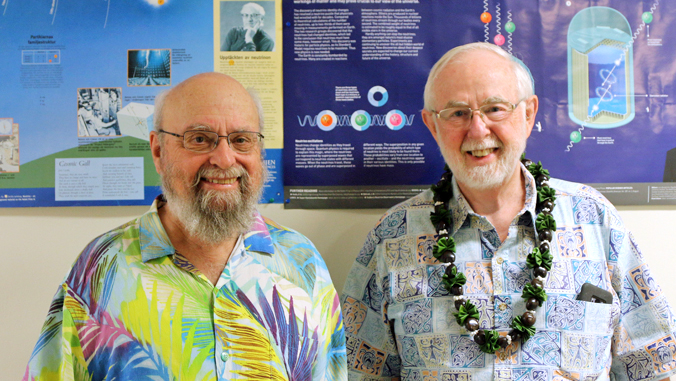
The University of Hawaiʻi at Mānoa has attracted top scientists in a variety of fields. Nobel Prize winning physicist and affiliate graduate faculty member of the physics and astronomy department Arthur B. McDonald has in recent years collaborated with colleagues and students on campus. He said he sees the work done with the faculty at UH Mānoa leads the world on a number of fronts.
The professor emeritus of Queen’s University, Canada won the Nobel Prize in physics in 2015 along with University of Tokyo professor Takaaki Kajita for their key experiments of subatomic particles known as neutrinos.
- Related UH News story: UH Affiliate Professor Arthur McDonald wins 2015 Nobel Prize in Physics, October 13, 2015

McDonald has spent several months a year since 2010 as an affiliate graduate faculty at UH Mānoa collaborating with colleagues on research projects. He is currently working with UH Mānoa Associate Professor Jelena Maricic on a next generation experiment to detect dark matter particles.
“When you look at the sky on a dark and starry night, there is five times as much mass in between the stars as there is in the stars themselves,” McDonald said. “The objective (of the upcoming experiment) is to attempt to observe legitimately a new form of matter that hasn’t been observed before.”
“It is a great pleasure collaborating with Professor McDonald as his experience and wisdom leads to very fruitful exchange of ideas and new creative outcomes,” Marcic said. “We discuss the variety of topics from calibration, to background control and development of new sensors to improve sensitivity and science reach of the DarkSide-20k which is the next phase of our joint project.”
McDonald and Maricic will be conducting the experiments in labs deep underground in Italy and Canada in order to help filter out other cosmic radiation.
UH colleagues say his presence on campus has led to important interactions and raising the university’s profile.
“Particularly as a Nobel Laureate from Canada, he has very high visibility and his influence is quite strong in Canada, the U.S. and on the international scale,” UH Mānoa Physics Professor John Learned said. “In residence here he works closely with us on various physics endeavors, and interacts with our graduate students on the technical and personal level. His presence raises the intellectual level of the department, university and even state. A great example was after a dinner this year that included a local technical business person, Art helped advance a new program with possible great long-term consequence for Hawaiʻi, and potentially all of humanity.”
McDonald pointed to a number of experiments and projects from the Department of Physics and Astronomy that are pushing at the cutting edge of research.
- ANITA—Professor Peter Gorham
- Super-Kamiokande detector in Japan that involved UH Professor Learned
- New discoveries through the UH Institute of Astronomy
“I think UH has a very enviable situation in this particular field that I’m involved in of particle astrophysics (doing physics and astronomy using particles),” McDonald said.
“The University of Hawaiʻi has managed to recruit some world leaders of various fields.”
McDonald believes these top leaders in the fields of physics and astronomy will continue to make significant contributions in the future.
“UH is going to continue to pursue topics that are at the frontier of this field and very major questions. Trying to understand our universe as a whole we’ve made tremendous progress in the last 20 years or so. The potential breakthroughs in the next 20 years are even more substantial,” he said.

